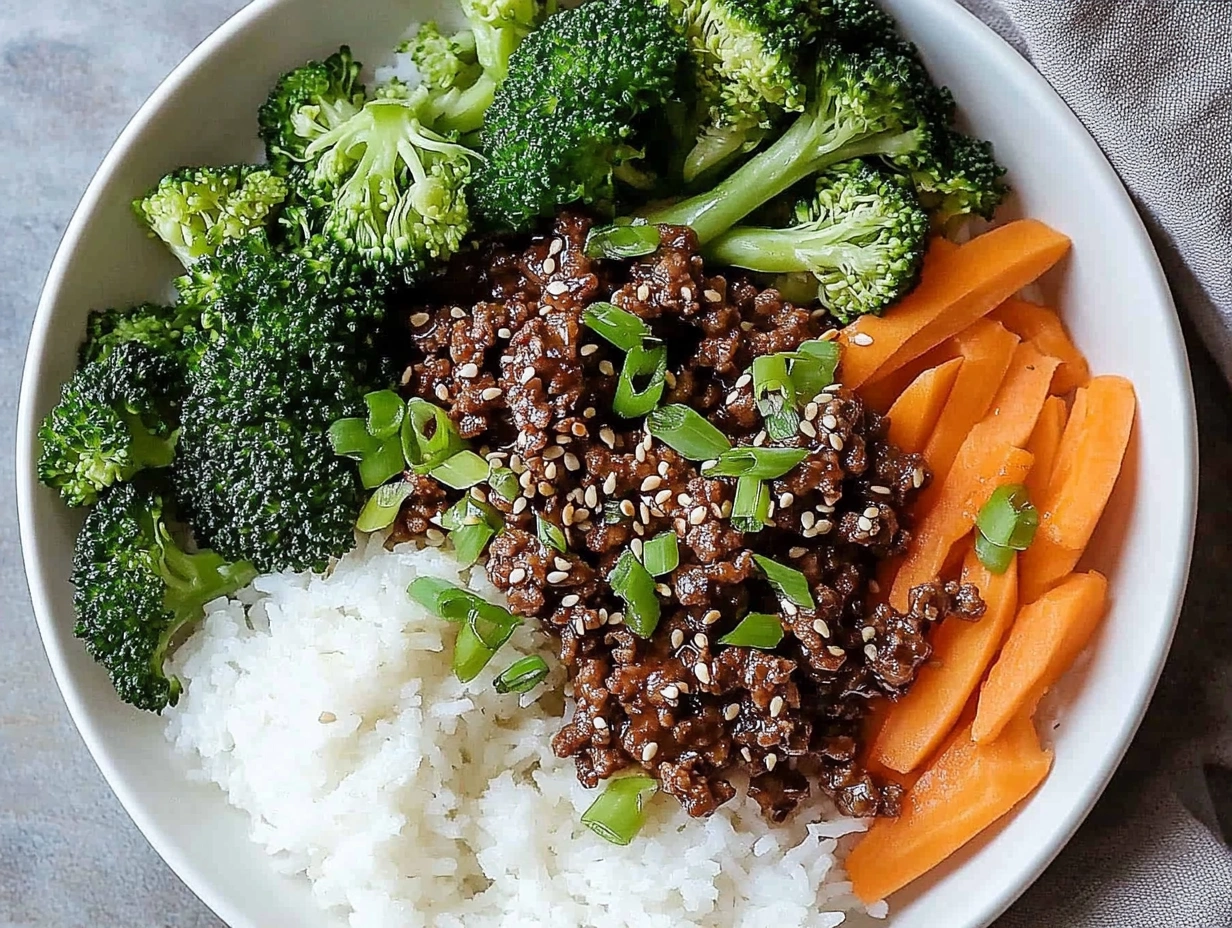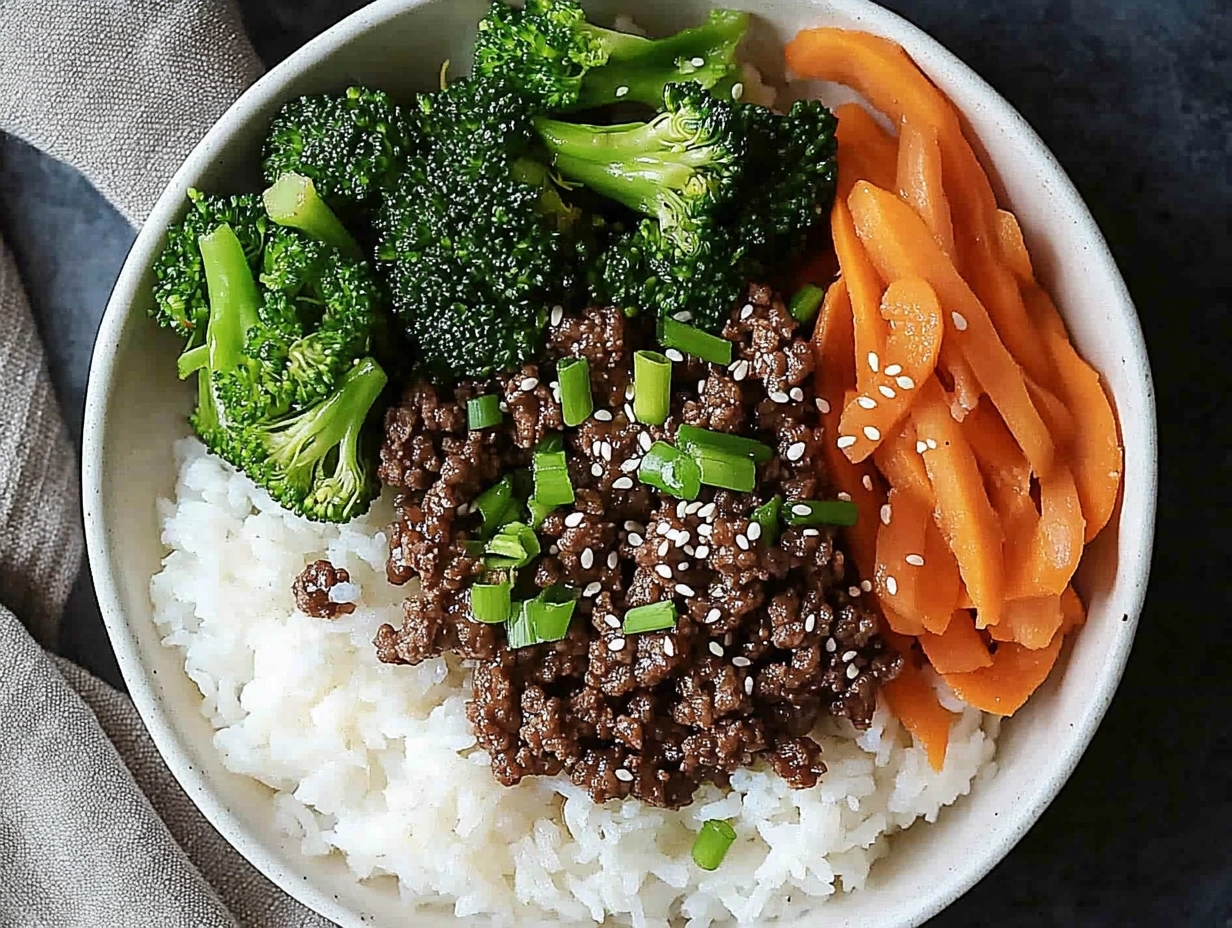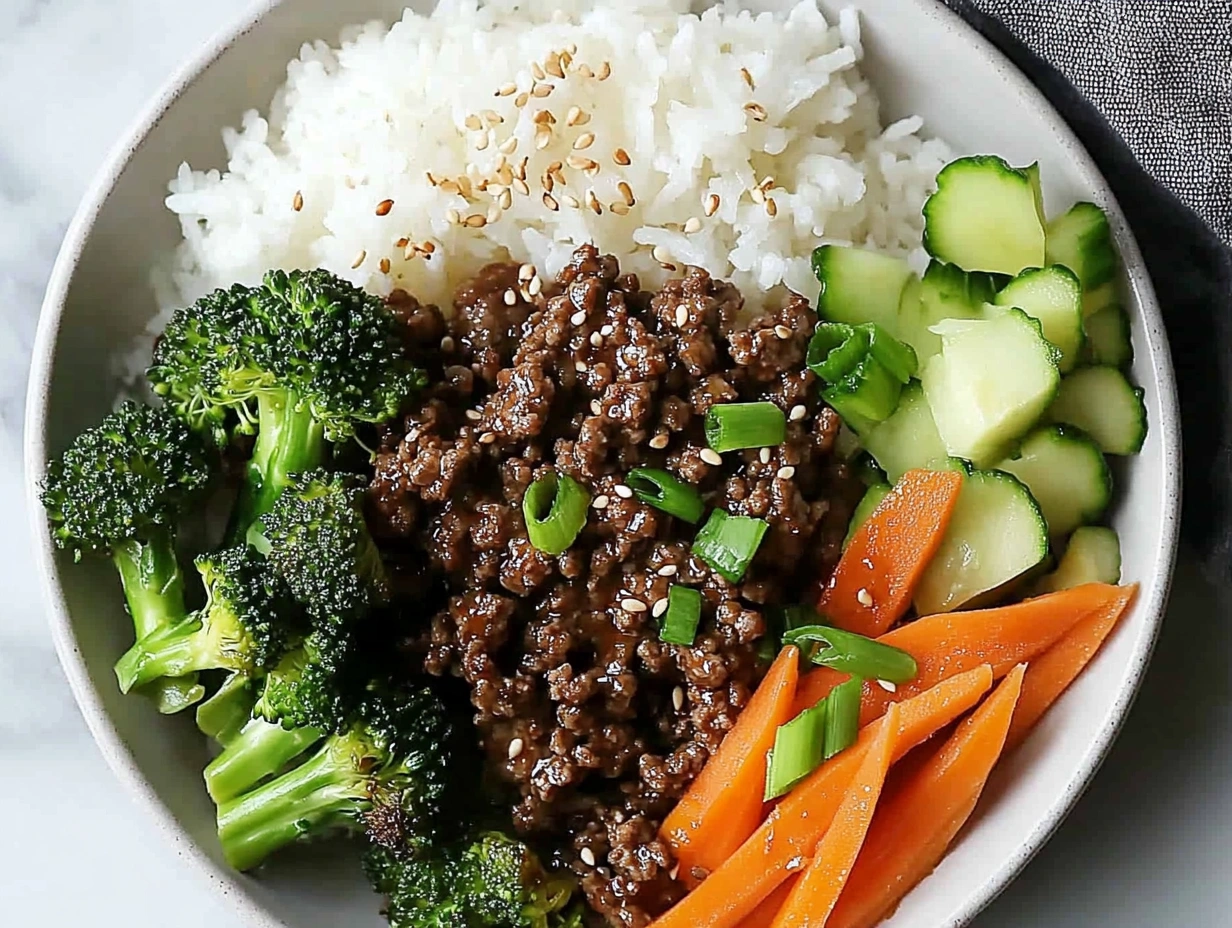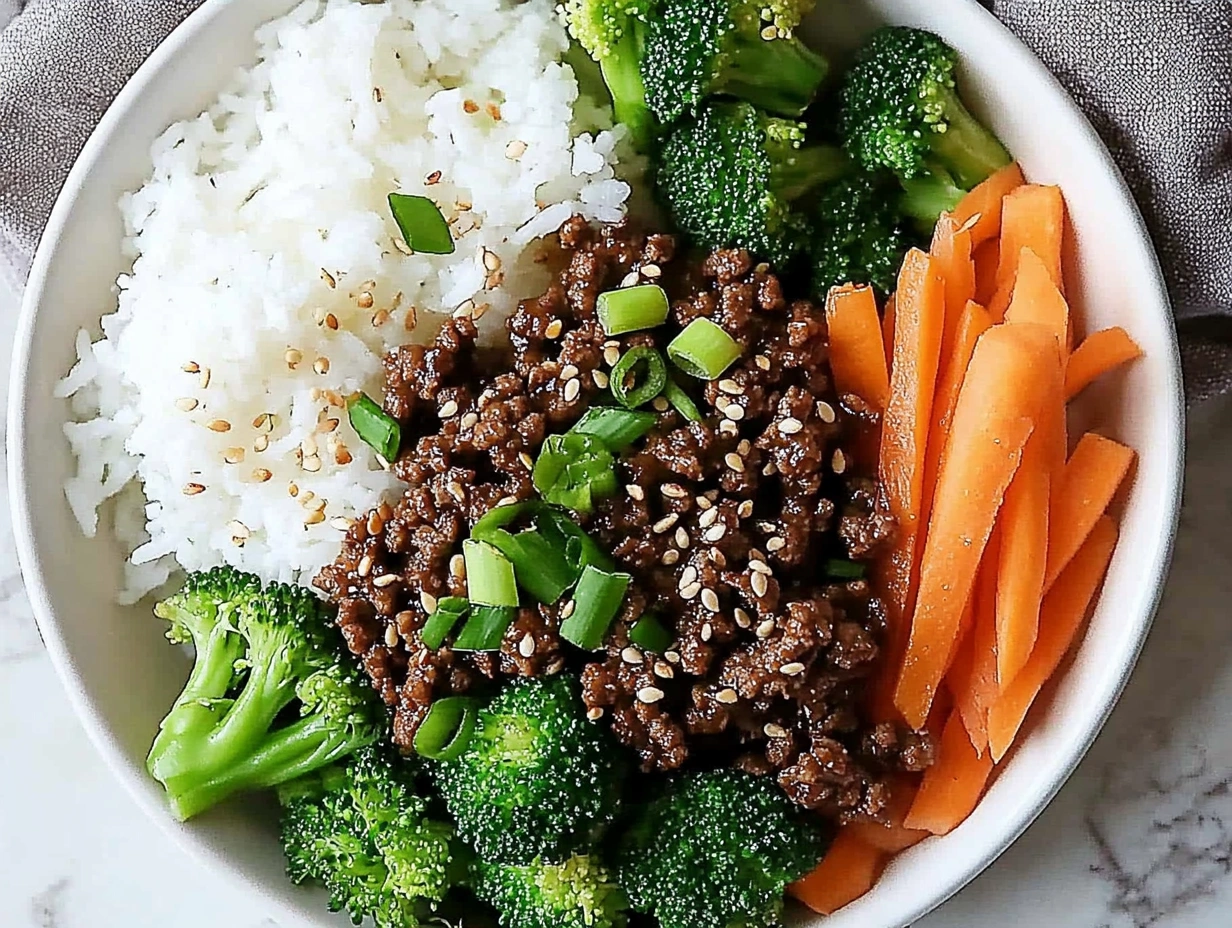Table of Contents
Introduction
There’s something inherently comforting about a warm bowl of rice topped with savory, flavorful meat and crisp vegetables. The Korean Beef Bowl encapsulates this comfort, offering a delightful blend of sweet, spicy, and umami flavors that dance on the palate. This dish, inspired by the traditional Korean bulgogi, has been adapted for the modern kitchen, making it accessible for home cooks seeking a quick yet satisfying meal.
Growing up in an Italian household, I was accustomed to hearty meals that brought the family together. When I first encountered Korean cuisine, I was captivated by its depth of flavor and communal dining style. The Korean Beef Bowl, with its rich marinade and customizable toppings, reminded me of the warmth and togetherness of my family’s dinners. It’s a dish that transcends cultural boundaries, bringing people together over a shared love for good food.

The Essence of Korean Beef Bowls
At its core, the Korean Beef Bowl is a harmonious combination of:
- Protein: Typically ground beef, marinated in a blend of soy sauce, brown sugar, garlic, and sesame oil.
- Base: Steamed white rice, though variations include brown rice, quinoa, or cauliflower rice.
- Vegetables: Fresh or pickled vegetables like cucumbers, carrots, and kimchi add crunch and acidity.
- Toppings: A fried egg, sesame seeds, and green onions elevate the dish, adding richness and visual appeal.
This dish is not only flavorful but also versatile, allowing for endless customization based on dietary preferences and available ingredients.

Ingredients (Serves 4)
For the Beef:
- 1 lb (450g) ground beef (80/20 or leaner)
- 3 cloves garlic, minced
- 1-inch piece of fresh ginger, grated
- 1/4 cup low-sodium soy sauce
- 2 tablespoons brown sugar
- 1 tablespoon sesame oil
- 1 tablespoon rice vinegar
- 1/2 teaspoon crushed red pepper flakes (adjust to taste)
- 1/4 teaspoon black pepper
- 2 green onions, thinly sliced
For the Bowl:
- 2 cups cooked white rice (or preferred base)
- 1 cup shredded carrots
- 1 cup sliced cucumbers
- 1 cup kimchi
- 4 fried eggs (optional)
- Sesame seeds, for garnish
Cooking Instructions
1. Prepare the Sauce
In a small bowl, whisk together the soy sauce, brown sugar, sesame oil, rice vinegar, crushed red pepper flakes, and black pepper. Set aside.
2. Cook the Beef
Heat a large skillet over medium-high heat. Add the ground beef, breaking it apart with a wooden spoon. Cook until browned and no longer pink, about 5-7 minutes. Drain excess fat if necessary.
Add the minced garlic and grated ginger to the skillet. Sauté for 1-2 minutes until fragrant.
Pour the prepared sauce over the beef. Stir to combine and let it simmer for 2-3 minutes, allowing the flavors to meld and the sauce to thicken slightly.
Stir in the sliced green onions, reserving some for garnish.

3. Assemble the Bowls
Divide the cooked rice among four bowls. Top each with an equal portion of the beef mixture.
Arrange the shredded carrots, sliced cucumbers, and kimchi around the beef.
If using, place a fried egg on top of each bowl.
Garnish with sesame seeds and the reserved green onions.
Nutritional Information (Per Serving)
Note: Nutritional values are approximate and may vary based on specific ingredients used.
- Calories: 480 kcal
- Protein: 29g
- Carbohydrates: 48g
- Fat: 19g
- Fiber: 3g
- Sugar: 10g
This dish offers a balanced meal with a good mix of protein, carbohydrates, and healthy fats. The inclusion of vegetables adds fiber and essential vitamins, making it both satisfying and nutritious.
Variations and Substitutions
Protein Alternatives
- Ground Turkey or Chicken: For a leaner option, substitute ground beef with ground turkey or chicken. Adjust seasoning as needed to maintain flavor depth.
- Tofu or Tempeh: For a vegetarian version, use crumbled tofu or tempeh. Ensure they are well-pressed to remove excess moisture before cooking.
Base Alternatives
- Brown Rice: Offers a nuttier flavor and additional fiber.
- Quinoa: A protein-rich alternative that’s gluten-free.
- Cauliflower Rice: A low-carb option suitable for keto diets.
Vegetable Additions
- Sautéed Spinach or Kale: Adds a dose of greens and nutrients.
- Pickled Radishes or Onions: Introduces tanginess and crunch.
- Bell Peppers or Zucchini: For added color and texture.
Sauce Enhancements
- Gochujang: A Korean chili paste that adds heat and depth.
- Hoisin Sauce: Introduces sweetness and complexity.
- Sriracha: For those who prefer a spicier kick.
Meal Prep and Storage Tips
The Korean Beef Bowl is an excellent candidate for meal prep. Here’s how to store and reheat:
- Refrigeration: Store components separately in airtight containers. The beef mixture can be refrigerated for up to 4 days.
- Freezing: The cooked beef can be frozen for up to 3 months. Thaw overnight in the refrigerator before reheating.
- Reheating: Warm the beef in a skillet over medium heat or microwave until heated through. Reheat rice separately to maintain texture.
When ready to eat, assemble the bowls with fresh vegetables and toppings for optimal taste and presentation.
Frequently Asked Questions (FAQs)
Q: Can I make this dish gluten-free?
A: Yes. Use tamari or coconut aminos instead of soy sauce, and ensure all other ingredients are gluten-free.
Q: Is this dish spicy?
A: The base recipe has a mild heat level. Adjust the amount of crushed red pepper flakes or add gochujang to increase spiciness according to your preference.
Q: Can I prepare the components ahead of time?
A: Absolutely. Cook the beef and rice in advance, and store them separately. Prepare fresh vegetables and toppings just before serving to maintain their crispness.
Q: What other toppings can I add?
A: Feel free to get creative. Avocado slices, shredded lettuce, bean sprouts, or a drizzle of spicy mayo can add new dimensions to the bowl.
Cultural Significance and Fusion Cuisine
The Korean Beef Bowl is a testament to the adaptability of traditional dishes. While rooted in the flavors of bulgogi, this version simplifies preparation without sacrificing taste. It’s a reflection of how culinary traditions evolve, embracing new techniques and ingredients while honoring their origins.
Incorporating elements from different cuisines, such as using ground beef common in American cooking, showcases the fusion nature of this dish. It’s a bridge between cultures, bringing together diverse flavors in a harmonious and accessible way.
Conclusion
The Korean Beef Bowl is more than just a meal; it’s an experience. It brings together the richness of Korean flavors with the convenience of modern cooking. Whether you’re seeking comfort on a cold winter night or a quick weeknight dinner, this dish delivers on all fronts.
Embrace the versatility of this recipe by experimenting with different proteins, bases, and toppings. Make it your own, and enjoy the journey of flavors that this bowl offers.
Print
Korean Beef Bowls: A Fusion of Flavor and Comfort
Ingredients
For the Beef:
-
1 lb (450g) ground beef (80/20 or leaner)
-
3 cloves garlic, minced
-
1-inch piece of fresh ginger, grated
-
1/4 cup low-sodium soy sauce
-
2 tablespoons brown sugar
-
1 tablespoon sesame oil
-
1 tablespoon rice vinegar
-
1/2 teaspoon crushed red pepper flakes (adjust to taste)
-
1/4 teaspoon black pepper
-
2 green onions, thinly sliced
For the Bowl:
-
2 cups cooked white rice (or preferred base)
-
1 cup shredded carrots
-
1 cup sliced cucumbers
-
1 cup kimchi
-
4 fried eggs (optional)
-
Sesame seeds, for garnish
Instructions
In a small bowl, whisk together the soy sauce, brown sugar, sesame oil, rice vinegar, crushed red pepper flakes, and black pepper. Set aside.
Heat a large skillet over medium-high heat. Add the ground beef, breaking it apart with a wooden spoon. Cook until browned and no longer pink, about 5-7 minutes. Drain excess fat if necessary.
Add the minced garlic and grated ginger to the skillet. Sauté for 1-2 minutes until fragrant.
Pour the prepared sauce over the beef. Stir to combine and let it simmer for 2-3 minutes, allowing the flavors to meld and the sauce to thicken slightly.
Stir in the sliced green onions, reserving some for garnish.
Divide the cooked rice among four bowls. Top each with an equal portion of the beef mixture.
Arrange the shredded carrots, sliced cucumbers, and kimchi around the beef.
If using, place a fried egg on top of each bowl.
Garnish with sesame seeds and the reserved green onions.
